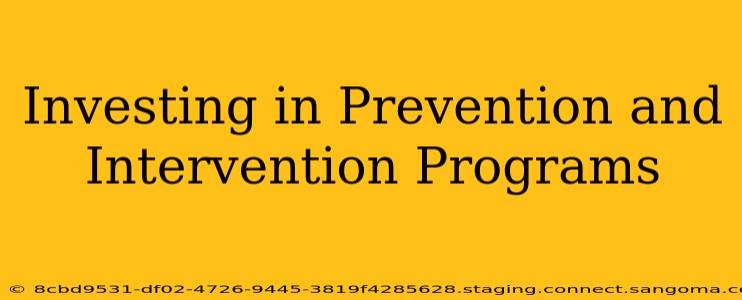Investing in Prevention and Intervention Programs: A Smart Strategy for a Healthier Future
Investing in prevention and intervention programs is more than just a cost; it's a strategic investment in a healthier, more productive, and safer society. While the initial outlay might seem significant, the long-term benefits—both in terms of human well-being and economic savings—far outweigh the expenses. This comprehensive guide explores the various aspects of investing in these crucial programs, addressing common questions and highlighting their profound impact.
Why Invest in Prevention and Intervention?
The core principle is simple: preventing problems is significantly cheaper and more effective than dealing with their consequences. Whether we're talking about preventing childhood obesity, addressing substance abuse, or mitigating the risks of chronic diseases, proactive measures save lives, reduce healthcare costs, and improve overall societal well-being. Consider the cost of treating a chronic illness like diabetes compared to the cost of promoting healthy eating habits and regular exercise. The difference is substantial.
What Types of Prevention and Intervention Programs Exist?
Prevention and intervention programs cover a wide spectrum of societal challenges. They can be broadly categorized as:
-
Primary Prevention: These programs aim to prevent problems from ever occurring. Examples include vaccination programs, public health campaigns promoting healthy lifestyles (e.g., anti-smoking initiatives), and educational programs teaching children about safety.
-
Secondary Prevention: These programs focus on early detection and intervention to prevent problems from worsening. Examples include screening programs for diseases (e.g., mammograms, colonoscopies), early intervention programs for children with developmental delays, and substance abuse counseling.
-
Tertiary Prevention: These programs aim to manage existing problems to prevent further complications or relapses. Examples include rehabilitation programs for individuals recovering from injuries or addiction, chronic disease management programs, and support groups.
What are the economic benefits of investing in prevention and intervention programs?
The economic benefits are substantial and multifaceted. By preventing problems, we reduce healthcare costs, improve workforce productivity, and decrease the need for costly social services. Studies consistently demonstrate that investing in prevention yields a significant return on investment, often exceeding the initial expenditure many times over. For example, a dollar invested in childhood obesity prevention can save several dollars in future healthcare costs associated with treating obesity-related diseases.
What are the challenges in implementing effective prevention and intervention programs?
Implementing effective programs faces several hurdles:
-
Funding limitations: Securing sufficient and sustainable funding is a major challenge. Many programs struggle to obtain the resources necessary to reach their full potential.
-
Political will: Sustained political commitment is crucial. Funding priorities can shift, leading to program cuts or interruptions, undermining their long-term effectiveness.
-
Reaching target populations: Ensuring programs reach the populations most in need often requires targeted outreach and community engagement strategies. Addressing inequalities in access to services is essential.
-
Evaluation and measurement: Demonstrating the effectiveness of prevention and intervention programs requires rigorous evaluation and data collection. This can be challenging, particularly with long-term programs.
How can we improve the effectiveness of prevention and intervention programs?
To maximize effectiveness:
-
Evidence-based practices: Programs should be grounded in robust scientific evidence.
-
Community engagement: Engaging communities in the design and implementation of programs is crucial for ensuring they meet local needs and are culturally appropriate.
-
Collaboration: Inter-agency and cross-sectoral collaboration is essential to maximize impact.
-
Long-term investment: Sustained funding and commitment over the long term are crucial for achieving lasting results.
-
Data-driven decision making: Regular monitoring and evaluation are essential to ensure programs are achieving their objectives and adapting to changing needs.
In conclusion, investing in prevention and intervention programs is a sound economic and social strategy. While challenges exist, the potential benefits—a healthier, more productive, and safer society—make this a vital investment for the future. By embracing evidence-based practices, fostering collaboration, and ensuring sustained funding, we can create a world where prevention and early intervention are cornerstones of a thriving society.

